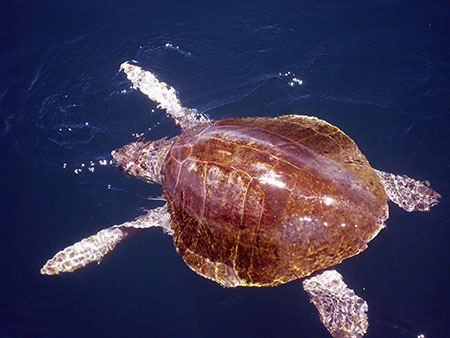
Fish & Shellfish Poisoning
Since seafood is frequently a staple for cruisers, it is important to be aware of the potential health risks associated with eating fish and shellfish. Parasites can be found in uncooked fish such as in sashimi and sushi. Toxins contained in certain fish or shellfish have the potential to cause significant illnesses such as scombroid poisoning, ciguatera poisoning and several types of shellfish poisonings. An excellent reference with a thorough discussion of fish and shellfish poisonings is: The Cruiser's Handbook of Fishing, by Scott and Wendy Bannerot (International Marine, 2000).
Pay close attention to red tide warnings (paralytic shellfish poisonings) and avoid eating raw or pickled fish such as sushi and sashimi (tapeworm and roundworm parasites). When buying fish, make sure it is properly refrigerated or kept on ice and not exposed to warm temperatures or sunlight for long periods of time (scombroid poisoning). Fish from the Scombridae family (tuna, mackerel, jacks, bonita, escolar) may produce scombroid fish poisoning when not properly refrigerated or kept cold. Warming produces high levels of histamine in the fish, which is not destroyed by cooking. The fish tends to taste metallic and peppery, and the histamine produces symptoms of an allergic reaction (itching, rash, and occasionally shortness of breath or wheezing). Treatment with an antihistamine (25-50 mg diphenhydramine [Benadryl]) produces significant relief in most cases. More severe symptoms should be treated as an allergic reaction (see Chapter 11, section 11.1).
Ciguatera - Most Common Fish Poisoning
Ciguatera is the most common form of fish poisoning (50,000 cases / year in tropical climates). In 1776 Captain Cook described what is believed to be ciguatera poisoning in some of his officers in Vanuatu. Ciguatera is formed from toxic microscopic coral algae that concentrate up the food chain as they are eaten by larger and larger reef fish. The geographic distribution of fish containing ciguatoxin extends from 35 degrees north to 35 degrees south and includes the Caribbean, South Pacific islands, the Red Sea and the Indian Ocean. The incidence of ciguatera fish poisoning is increasing as fish consumption in the United States increases and the fishing industries of affected areas increase their export of fish worldwide. Unfortunately, the toxin is not affected by freezing, drying or heating, and toxic fish have normal taste, odor and texture.
Prevention
Avoid eating large reef predators and other fish species known to carry the ciguatera toxin. These may include barracuda, grouper, snapper, sea bass, surgeonfish, jacks, parrotfish and moray eels. Whether a fish is ciguatoxic depends on the species, size, location and depth of capture. Local knowledge may be helpful, but many fishermen are marketing fish known to be ciguatoxic. A new test kit called Cigua-Check (has been developed in Hawaii and is now available for onboard use. I have not personally used the kit. (www.cigua.com or (808) 591-9620).
Common signs and symptoms of ciguatera poisonings occur two to 12 hours following ingestion and may include: stomach upset (nausea, vomiting and diarrhea), tingling or numbness, itching and hot-cold sensory reversal, where hot objects feel cold and cold objects feel hot. Symptoms may persist for days or months.
Treatment
Unfortunately, there are limited first aid and treatment measures for ciguatera poisonings. Vomiting should be induced in the fully awake and alert patient within 45 minutes of ingestion. Charcoal (liquid, not the briquettes), may be given within 4-5 hours of ingestion, 1 gram of charcoal per kilo of weight. For severe symptoms, hospitalization is often necessary.
Personal Tips
Prior to the Cigua-Check (test kit, it was common advice to feed a small portion of suspected fish to your pet. If your pet became ill (or died), you knew the fish was not safe to eat. I never felt this was a good idea but found that friends of ours (who will remain nameless) did exactly the same thing to us. We proudly presented them with half a red snapper in the Sea of Cortez. Early the following morning, they contacted us by radio to see how we were feeling. They said they were waiting to eat their fish until they knew we had not become ill after eating ours. Very funny.
About the Authors
Jan Loomis is a registered nurse and paramedic who is currently cruising with her husband, Geoff Wickes, aboard their Valiant 40, Meridian Passage. She holds a faculty appointment at Oregon Health & Science University where she works in the emergency department and was formerly the coordinator of the Travel Medicine Clinic. She has sailed the Tasman Sea, Caribbean, Pacific Northwest, Kingdom of Tonga, Australia, and, most recently, Mexico and the Sea of Cortez.
James Bryan is a board certified emergency physician at the Portland Veteransí Affairs Medical Center and Oregon Health & Science University. He holds a PhD in Pharmacology and is the lead editor of the EMRA Guide to Antibiotic Use in the Emergency Department. He is an active member of the Wilderness Medical Society and has participated in wilderness search and rescue for over twenty-five years.
The Healthy Cruiser's Handbook, Prevention and Treatment Medical Resource Guide (ISBN# 0-9721077-0-3) is available from Seaworthy Publications, 215 S. Park Street, Suite #1, Port Washington, WI 53074, (262) 268-9250, www.seaworthy.com
by Janette Loomis, RN, BS, Meridian Passage and James H. Bryan, MD, PhD from
The Healthy Cruiser's Handbook, Prevention and Treatment Medical Resource Guide